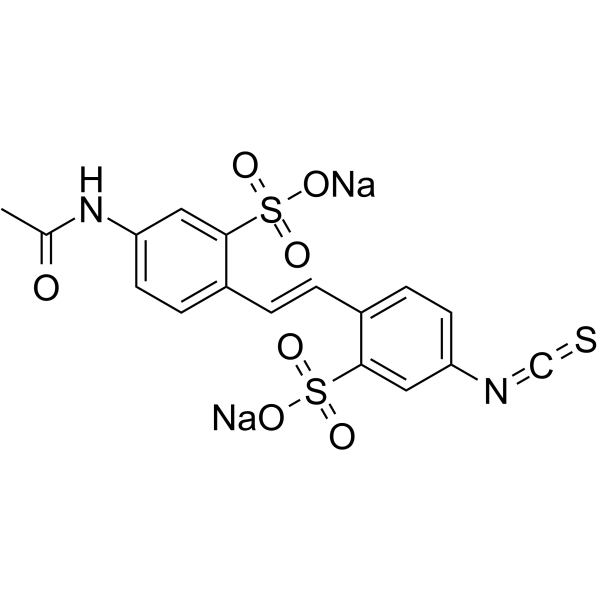sits

sits structure
|
Common Name | sits | ||
|---|---|---|---|---|
| CAS Number | 51023-76-8 | Molecular Weight | 498.461 | |
| Density | 1.52g/cm3 | Boiling Point | N/A | |
| Molecular Formula | C17H12N2Na2O7S3 | Melting Point | >300ºC (dec.) | |
| MSDS | Chinese USA | Flash Point | N/A | |
| Symbol |


GHS07, GHS08 |
Signal Word | Danger | |
Use of sits4-Acetamido-4'-isothiocyanatostilbene-2,2'-disulfonic acid disodium is a fluorescent dye. 4-Acetamido-4'-isothiocyanatostilbene-2,2'-disulfonic acid disodium can be used to demonstrate retrograde axonal transport to label secondary antibodies and as a fluorescent whole cell stain[1]. |
| Name | 4-Acetamido-4'-isothiocyanatostilbene-2,2'-disulfonic Acid, Sodium Salt |
|---|---|
| Synonym | More Synonyms |
| Description | 4-Acetamido-4'-isothiocyanatostilbene-2,2'-disulfonic acid disodium is a fluorescent dye. 4-Acetamido-4'-isothiocyanatostilbene-2,2'-disulfonic acid disodium can be used to demonstrate retrograde axonal transport to label secondary antibodies and as a fluorescent whole cell stain[1]. |
|---|---|
| Related Catalog | |
| References |
| Density | 1.52g/cm3 |
|---|---|
| Melting Point | >300ºC (dec.) |
| Molecular Formula | C17H12N2Na2O7S3 |
| Molecular Weight | 498.461 |
| Exact Mass | 497.960205 |
| PSA | 204.71000 |
| LogP | 4.59250 |
| Storage condition | 2-8°C |
| Stability | Temperature sensitive - recommended storage at -20oC |
| Symbol |


GHS07, GHS08 |
|---|---|
| Signal Word | Danger |
| Hazard Statements | H302-H315-H319-H334-H335 |
| Precautionary Statements | P261-P284-P301 + P312 + P330-P304 + P340-P305 + P351 + P338-P342 + P311 |
| Personal Protective Equipment | dust mask type N95 (US);Eyeshields;Faceshields;Gloves |
| Hazard Codes | Xn |
| Risk Phrases | R22 |
| Safety Phrases | S22-S26-S36/37 |
| RIDADR | NONH for all modes of transport |
| WGK Germany | 3 |
|
Excitation of rat sympathetic neurons via M1 muscarinic receptors independently of Kv7 channels.
Pflugers Arch. 466(12) , 2289-303, (2014) The slow cholinergic transmission in autonomic ganglia is known to be mediated by an inhibition of Kv7 channels via M1 muscarinic acetylcholine receptors. However, in the present experiments using pri... |
|
|
Tuning the reactivity in classic low-spin d6 rhenium(I) tricarbonyl radiopharmaceutical synthon by selective bidentate ligand variation (L,L'-Bid; L,L'= N,N', N,O, and O,O' donor atom sets) in fac-[Re(CO)3(L,L'-Bid)(MeOH)]n complexes.
Inorg. Chem. 50(24) , 12486-98, (2011) A range of fac-[Re(CO)(3)(L,L'-Bid)(H(2)O)](n) (L,L'-Bid = neutral or monoanionic bidentate ligands with varied L,L' donor atoms, N,N', N,O, or O,O': 1,10-phenanthroline, 2,2'-bipydine, 2-picolinate, ... |
|
|
Mechanisms of chloride in cardiomyocyte anoxia-reoxygenation injury: the involvement of oxidative stress and NF-kappaB activation.
Mol. Cell Biochem. 355(1-2) , 201-9, (2011) During anoxia/reoxygenation (A/R) injury, intracellular chloride ion concentration ([Cl(-)](i)) homeostasis may play a role in maintaining the normal physiological function of cardiomyocytes. Various ... |
| EINECS 256-919-4 |
| SITS |
| Benzenesulfonic acid, 5-(acetylamino)-2-[(E)-2-(4-isothiocyanato-2-sulfophenyl)ethenyl]-, sodium salt (1:2) |
| Disodium 5-acetamido-2-[(E)-2-(4-isothiocyanato-2-sulfonatophenyl)vinyl]benzenesulfonate |
| MFCD00007485 |
| 4-Acetamido-4'-isothiocyanatostilbenedisulfonic acid disodium salt |
| SITS [4-Acetamido-4'-isothiocyanatostilbene-2,2'-disulfonic acid,disodium salt] |